最新初中英语教案(英文版)资料
初中英语教案(优秀7篇)
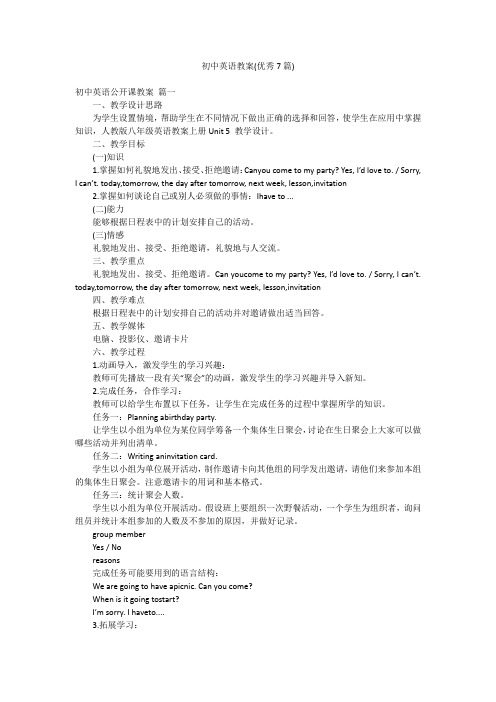
初中英语教案(优秀7篇)初中英语公开课教案篇一一、教学设计思路为学生设置情境,帮助学生在不同情况下做出正确的选择和回答,使学生在应用中掌握知识,人教版八年级英语教案上册Unit 5 教学设计。
二、教学目标(一)知识1.掌握如何礼貌地发出、接受、拒绝邀请:Canyou come to my party? Yes, I’d love to. / Sorry,I can’t. today,tomorrow, the day after tomorrow, next week, lesson,invitation2.掌握如何谈论自己或别人必须做的事情:Ihave to ...(二)能力能够根据日程表中的计划安排自己的活动。
(三)情感礼貌地发出、接受、拒绝邀请,礼貌地与人交流。
三、教学重点礼貌地发出、接受、拒绝邀请。
Can youcome to my party? Yes, I’d love to. / Sorry, I can’t. today,tomorrow, the day after tomorrow, next week, lesson,invitation四、教学难点根据日程表中的计划安排自己的活动并对邀请做出适当回答。
五、教学媒体电脑、投影仪、邀请卡片六、教学过程1.动画导入,激发学生的学习兴趣:教师可先播放一段有关“聚会”的动画,激发学生的学习兴趣并导入新知。
2.完成任务,合作学习:教师可以给学生布置以下任务,让学生在完成任务的过程中掌握所学的知识。
任务一:Planning abirthday party.让学生以小组为单位为某位同学筹备一个集体生日聚会,讨论在生日聚会上大家可以做哪些活动并列出清单。
任务二:Writing aninvitation card.学生以小组为单位展开活动,制作邀请卡向其他组的同学发出邀请,请他们来参加本组的集体生日聚会。
注意邀请卡的用词和基本格式。
任务三:统计聚会人数。
初中英语教案(优秀4篇)
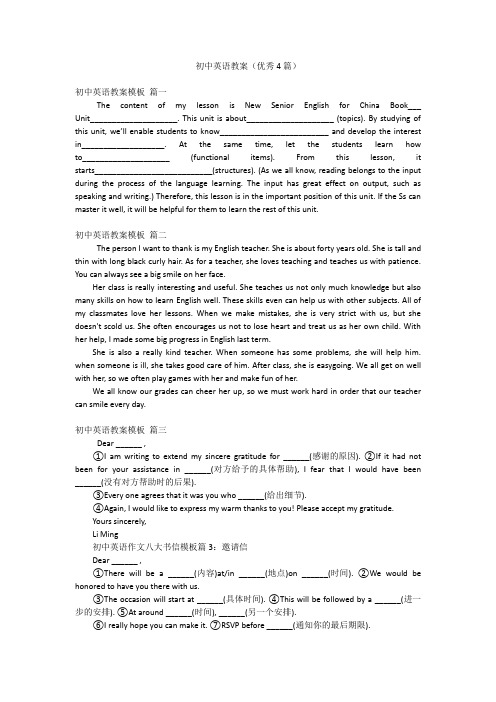
初中英语教案(优秀4篇)初中英语教案模板篇一The content of my lesson is New Senior English for China Book___ Unit____________________. This unit is about____________________ (topics). By studying of this unit, we’ll enable students to know_________________________ and develop the interest in___________________. At the same time, let the students learn how to____________________ (functional items). From this lesson, it starts___________________________(structures). (As we all know, reading belongs to the input during the process of the language learning. The input has great effect on output, such as speaking and writing.) Therefore, this lesson is in the important position of this unit. If the Ss can master it well, it will be helpful for them to learn the rest of this unit.初中英语教案模板篇二The person I want to thank is my English teacher. She is about forty years old. She is tall and thin with long black curly hair. As for a teacher, she loves teaching and teaches us with patience. You can always see a big smile on her face.Her class is really interesting and useful. She teaches us not only much knowledge but also many skills on how to learn English well. These skills even can help us with other subjects. All of my classmates love her lessons. When we make mistakes, she is very strict with us, but she doesn't scold us. She often encourages us not to lose heart and treat us as her own child. With her help, I made some big progress in English last term.She is also a really kind teacher. When someone has some problems, she will help him. when someone is ill, she takes good care of him. After class, she is easygoing. We all get on well with her, so we often play games with her and make fun of her.We all know our grades can cheer her up, so we must work hard in order that our teacher can smile every day.初中英语教案模板篇三Dear ______ ,①I am writing to extend my sincere gratitude for ______(感谢的原因). ②If it had not been for your assistance in ______(对方给予的具体帮助), I fear that I would have been ______(没有对方帮助时的后果).③Every one agrees that it was you who ______(给出细节).④Again, I would like to express my warm thanks to you! Please accept my gratitude.Yours sincerely,Li Ming初中英语作文八大书信模板篇3:邀请信Dear ______ ,①There will be a ______(内容)at/in ______(地点)on ______(时间). ②We would be honored to have you there with us.③The occasion will start at ______(具体时间). ④This will be followed by a ______(进一步的安排). ⑤At around ______(时间), ______(另一个安排).⑥I really hope you can make it. ⑦RSVP before ______(通知你的最后期限).Yours sincerely,Li Ming初中英语作文八大书信模板篇4:建议信Dear ______,①You have asked me for my advice with regard to ______ , and I will try to make some conductive suggestions here.②In my humble opinion, you would be wise to take the following actions: ______(建议的内容).③I hope you will find these proposals useful, and I would be ready to discuss this matter with you to further details.Yours sincerely,Li Ming初中英语作文八大书信模板篇5:投诉信Dear ______,①I am ______(自我介绍). ②I feel bad to trouble you but I am afraid that I have to make a plaint about.③The reason for my dissatisfaction is ______(总体介绍). ④In the first place, ______(抱怨的第一个方面). ⑤In addition, ______(抱怨的第二个方面). ⑥Under these circumstances, I find it ______(感觉)to______(抱怨的方面给你带来的后果).⑦I appreciate it very much if you could ______(提出建议和请求), preferably ______(进一步的要求), and I would like to have this matter settled by ______(设定解决事情最后期限).⑧Thank you for your consideration and I will be looking forward to your reply.初中英语作文八大书信模板篇6:祝贺信Dear ______ ,①I have learned with delight that you ______(祝贺事由). ②I would like to extend to you my utmost congratulations on ______. ③You must be ______. ④And I feel very happy for you.⑤ ______(所取得的成绩)is quite exciting news! ⑥I know this is surely owing to ______(被祝贺人过去的努力).⑦It is a reward you richly deserve for your ______(被祝贺人的优点).⑧Kindly let me know when you ______(咨询对方何时有空).⑨I hope ______(表达自己的愿望). ⑩My best wishes for your further success.Yours sincerely,Li Ming初中英语作文八大书信模板篇7:请求信Dear ______ ,①I am writing to formally request to ______(请求的内容).②The reason for ______is that ______(给出原因). ③I ______ , so I ______(给出细节).④I would also like to request ______(提出进一步的要求). ⑤I am sorry for any inconvenience I have caused.⑥Thank you for your attention to these requests. ⑦If you have any questions, do not hesitate to contact me at ______(电话号码). ⑧I look forward to a favorable reply.Yours sincerely,Li Ming初中英语作文八大书信模板篇8:推荐信Dear ______ ,①It affords me much pleasure to remend ______(要推荐的人)to you.②During his/her graduate years he/she was my ______ . ③As his/her ______ I found him/her ______(介绍与此人的关系).④His/Her performance in the school years was outstanding. ⑤First, he/she had been and showed great talents in ______ . ⑥In addition, he/she has a very pleasant personality. ⑦He has developed a strong sense of ______, and working with him is always. ⑧I can state that he/she has all the qualities of being ______.(介绍此人的能力)⑨Therefore, I here remend him/her to you with all my heart. ⑩Should you favor him/her with a position in your pany/Should you accept him/her in your university?I am sure that his/her future conduct/academic work will prove worthy of your confidence. I look forward to hearing from you at the earliest possible moment.Yours sincerely,Li MingMy life is from opened his eyes and fell in love with my mothers George Eliot我的家庭(My family)There are 3 members in our family,my father,my mother and love each other father likes reading....【篇一】保护环境Protect the EnvironmentRecently, the news reported that one special kind of rhino from Africa just passed away, which meant the disappearance of this lovely creature. What a great pity....【篇一】环境保护:假如你是李华,现任你们学校的学生会主席。
初中仁爱版英语教案3篇仁爱版初中英语教案英文版
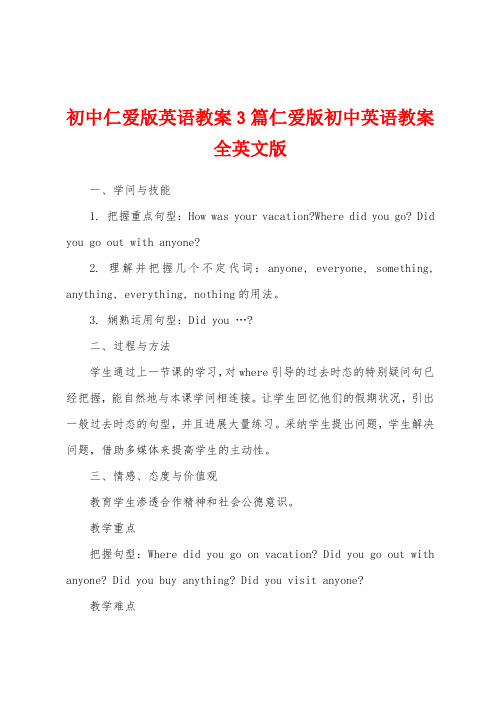
初中仁爱版英语教案3篇仁爱版初中英语教案全英文版一、学问与技能1. 把握重点句型:How was your vacation?Where did you go? Did you go out with anyone?2. 理解并把握几个不定代词:anyone, everyone, something, anything, everything, nothing的用法。
3. 娴熟运用句型:Did you …?二、过程与方法学生通过上一节课的学习,对where引导的过去时态的特别疑问句已经把握,能自然地与本课学问相连接。
让学生回忆他们的假期状况,引出一般过去时态的句型,并且进展大量练习。
采纳学生提出问题,学生解决问题,借助多媒体来提高学生的主动性。
三、情感、态度与价值观教育学生渗透合作精神和社会公德意识。
教学重点把握句型:Where did you go on vacation? Did you go out with anyone? Did you buy anything? Did you visit anyone?教学难点能用句型Did you …?提出尽可能多的有关过去假期的问题。
教法导航创设情境,让学生自己总结规律,思索,争论,最终得出结论。
创设英语语言气氛,使学生能较快地融入到英语语言学习的情景中来。
学法导航自主学习,独立思索,小组争论,同桌合作,完成学习任务。
教学预备视频,图片,多媒体。
教学过程Step 1 GreetingsGreet the class as usual.Step 2 RevisionAsk the students to look at the picture on Page 1 and make conversations, using the sentence pattern: —Where did you go on vacation? —I went to the mountains. —Did you go with anyone? —Yes, I did. / No, I didn’t.Step 3 Role playThe teacher acts as Rick and ask a student to act as Helen and practice the dialogue of 2d on Page 2. Then ask the students to practice in pairs and finally ask two or three pairs to act it out.Step 4 Grammar FocusReview the grammar box. Ask students to say the questions and answers.Review the difference between regular –ed past tense verbs (stay –stayed, visit-visited) and irregular past tense verbs (go –went, buy-bought). Then get the students to ask and answer the questions and answers in pairs.Step 5 GameAsk one student to act as the teacher and ask some individual students questions. Get as many students as possible to be the teacher.Then ask the students to pay attention to the words: no one, anyone, everyone, something, nothing, anything.Step 6 Practice3a Fill in the blanks with the words in the box and practice the conversation.3b Fill in the blanks in the e-mail mestudentsage with the words in the box.After checking the answers, get the students to read them aloud. Step 7 Group workMake a survey. Ask the students to make a survey by asking the questions about their last vacation: Did you eat anything at a reastaurant? Did you read anything interesting? ….Make sure the students practice the dialogues again and again and write down the results in the form. Then ask some students to report their results. Step 8 HomeworkAsk your classmates as many questions about their last vacation as possible.课堂作业Fill in the blanks.1. Where ___ you ___ (go) on vacation?2. I ___ (go) to New York City.3. —___ you ___ (go) out with ______? —No. No one was here. Everyone was on vacation.4. —Did you buy _______ special? —Yes, I _______ (buy) something for my father.5. —___ was the food? –Everything tasted really good!参考答案:1. did, go 2. went 3. Did, go, anyone 4. anything, bought 5. How教学反思为了避开语法学习的枯燥,本课设计了几个小组活动和小嬉戏,让学生在不知不觉中就把握了学问,学习效果较好。
版初中英语教案全英文【8篇】

版初中英语教案全英文【优秀8篇】最新初中英语教案篇一一、教学目标在本节课结束时,学生将能够:用正确的语言谈论如何学习;用by+ doing的结构描述自己的学习方式;能够就英语学习与他人进行简单的口语交流。
知识与能力:通过本课学习,用目标语言谈论如何学习英语,就英语问题进行简单的沟通,同时在与他人的合作与交流中帮助他人,树立自己学习的信心。
过程与方法:采用小组合作探究、听力练习、对话练习、猜测问题和角色互换的学习策略,利用视频、PPT和制作课件等来展开课堂教学环节等,进行“询问和谈论学习方法、解决困惑” 的课堂教学和练习。
本单元的教学法建议:短语教学——采取情景引入展开启发式的教学方式,让学生在思考中输出自己的语言,并在句型中学会运用;语音教学——让学生进行听对话并跟读听力材料;口语教学——采取对话练习和角色互换对学生进行教学;听力教学——采取听音配对、听音打钩和听音对应等的方式进行听力教学和听力技巧指导;口语教学——通过创设情境让学生进行对话练习和角色互换活动,来进行语言的输出。
情感态度与价值观:通过参与课题教学活动,增进同学之间的了解和友情,并在交流中了解英语学习的方法,建立学习英语的自信。
二、教学重难点教学重点:学习并掌握How do you study...? I study...by ....等相关句型和词汇。
学习并掌握用by + doing 结构表达方式方法。
教学难点:学习并用丰富的语言描述英语学习的方式和方法。
三、教学策略短语教学——采取视频引入话题然后进行启发式教学,并在对话中运用;语音教学——让学生跟读听力材料进行模仿式操练;口语教学——采取pair work 和Role- play问答式的口语交际活动或小组活动互相操练;听力教学——采取采取听音配对、听音打钩和听音对应等方式语法教学——通过模仿听力材料进行对话练习,在教师的纠正中培养正确的by + doing 的结构意识。
初中英语公开课教案篇二课前准备教师:准备游戏时所用的图片(食物、蔬菜、动物)。
初中英语全英说课稿优秀9篇
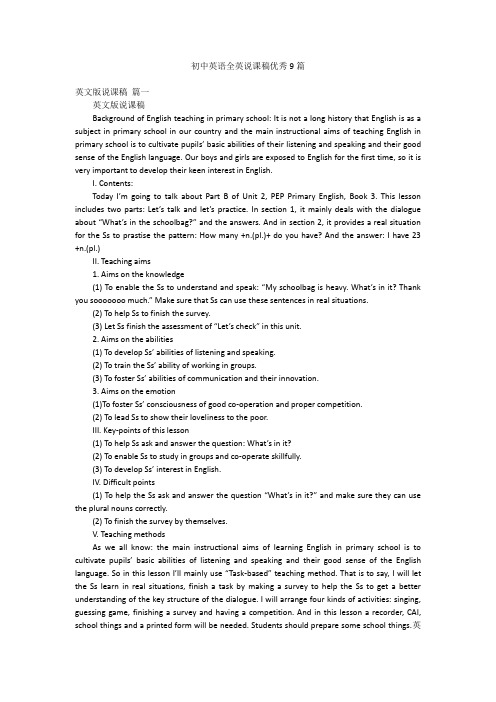
初中英语全英说课稿优秀9篇英文版说课稿篇一英文版说课稿Background of English teaching in primary school: It is not a long history that English is as a subject in primary school in our country and the main instructional aims of teaching English in primary school is to cultivate pupils’ basic abilities of their listening and speaking and their good sense of the English language. Our boys and girls are exposed to English for the first time, so it is very important to develop their keen interest in English.I. Contents:Today I’m going to talk about Part B of Unit 2, PEP Primary English, Book 3. This lesson includes two parts: Let’s talk and let’s practice. In section 1, it mainly deals with the dialogue about “What’s in the schoolbag?” and the answers. And in section 2, it provides a real situation for the Ss to prastise the pattern: How many +n.(pl.)+ do you have? And the answer: I have 23 +n.(pl.)II. Teaching aims1. Aims on the knowledge(1) To enable the Ss to understand and speak: “My schoolbag is heavy. What’s in it? Thank you sooooooo much.” Make sure that Ss can use these sentences in real situations.(2) To help Ss to finish the survey.(3) Let Ss finish the assessment of “Let’s check” in this unit.2. Aims on the abilities(1) To develop Ss’ abilities of listening and speaking.(2) To train the Ss’ ability of working in groups.(3) To foster Ss’ abilities of communication and their innovation.3. Aims on the emotion(1)To foster Ss’ consciousness of good co-operation and proper competition.(2) To lead Ss to show their loveliness to the poor.III. Key-points of this lesson(1) To help Ss ask and answer the question: What’s in it?(2) To enable Ss to study in groups and co-operate skillfully.(3) To develop Ss’ interest in English.IV. Difficult points(1) To help the Ss ask and answer the question “What’s in it?” and make sure they can use the plural nouns correctly.(2) To finish the survey by themselves.V. Teaching methodsAs we all know: the main instructional aims of learning English in primary school is to cultivate pupils’ basic abilities of listening and speaking and their good sense of the English language. So in this lesson I’ll mainly use “Task-based” teaching method. That is to say, I will let the Ss learn in real situations, finish a task by making a survey to help the Ss to get a better understanding of the key structure of the dialogue. I will arrange four kinds of activities: singing, guessing game, finishing a survey and having a competition. And in this lesson a recorder, CAI, school things and a printed form will be needed. Students should prepare some school things.英文版英语说课稿VI. Teaching procedures and purposes of my designing.I’ll finish this lesson in five steps.Step 1. Warm-up and preview1. Free talk between T and Ss about things in the classroom.2. Sing the song together: Books and pencils.3. Do some TPR, for example: Show me your English book. Show me your crayon.4. Review the numbers by asking: “How many crayons do you have?”Purpose: It is important to form a better English learning surrounding for the Ss by singing and doing some total physical response and at the same time it provides situations to review learned knowledge for the next step.Step 2. PresentationNow I’ll mainly talk about this step.1. Present the pattern: “My schoolbag is heavy.” “What’s in it?.”(1) Show a bag and say: “Look! I have a bag.” Carry it and say: “Oh, it is heavy. My schoolbag is heavy.” Help the Ss understand the meaning with the help of my body language. Then lead the Ss to read the sentence. Make sure they can say it correctly.(2) T: My schoolbag is heavy.Open the bag and say: “What’s in it? What’s in my schoolbag?”Take out a Chinese book. Then do the action again. Let the Ss read the sentence.2. Play a guessing game. Divide the whole class into four groups to have a competition.Let them guess: What’s in the bag? How many? Purpose: To present the key structures one by one is much easier for the Ss to learn and grasp the meanings. Proper competition can arouse the Ss’ interest in English learning.3. With the help of the CAI to present the dialogue. Set a situation to help Ss understand: Two Ss are coming. One girl is carrying a heavy bag on her back. They are talking.Girl: My schoolbag is heavy.Boy: What’s in it?Girl: 20 story-books, 32 pencil, 9 rulers, 12 crayons and 30 picture-books. Etc.Boy: What will you do?Girl: They are for the poor.Boy: Great! I’ll bring some school things too.The boy comes back home and puts a lot of things into the bag. Then he goes to school again and gives them to a teacher. While he is taking them out, he is counting the numbers of all things. The teacher says: Thank you soooooooo much.4. Mention that we should take care of the poor.5. Play the cassette. Let the Ss listen and imitate the dialogue.Pay attention to their pronunciation and intonation. Purpose: CAI can provide a real situation for the Ss to understand the dialogue and the relationships between people better. Tell the Ss we should show our loveliness to the Ss.Step 3. PracticeDivide Ss into groups of six children. Each one would finish the printed form by asking and answering: How many storybooks do you have? Find out which group finishes faster. Story books picture-books sharpeners crayons pencils erasers pencil-cases rulers Chen Jie 8 24 3 32 26 4 1 3Purpose: Task-based teaching method is used here to develop Ss’ ability of communication and also their ability of co-operation will be well trained.Step 4. AssessmentHelp Ss finish “Let’s check” of this unit and workbook.Purpose: To check the knowledge Ss have learned in this period.Step 5. Add-activity1. Let Ss tell each other how many school things they have after class. Tell their parents how many school things they have at home.2. Take care of everything they have.Purpose: Revision is so important that Ss should speak English as much as they as in class or after class. It is necessary for the Ss to do some extensive exercises after class to consolidate the knowledge they learned.英文版英语说课稿初中英语说课稿篇二今天我的说课内容是新目标英语八年级上册第四单元第一课时。
中学英语教案范文急求初中英语教案模板英文版的
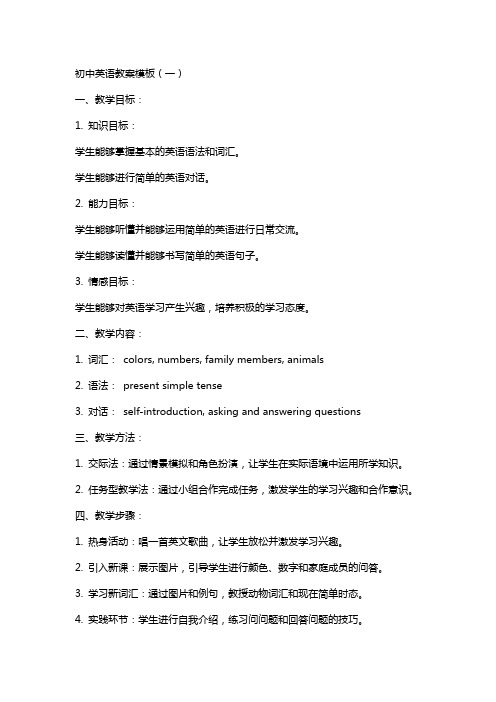
初中英语教案模板(一)一、教学目标:1. 知识目标:学生能够掌握基本的英语语法和词汇。
学生能够进行简单的英语对话。
2. 能力目标:学生能够听懂并能够运用简单的英语进行日常交流。
学生能够读懂并能够书写简单的英语句子。
3. 情感目标:学生能够对英语学习产生兴趣,培养积极的学习态度。
二、教学内容:1. 词汇:colors, numbers, family members, animals2. 语法:present simple tense3. 对话:self-introduction, asking and answering questions三、教学方法:1. 交际法:通过情景模拟和角色扮演,让学生在实际语境中运用所学知识。
2. 任务型教学法:通过小组合作完成任务,激发学生的学习兴趣和合作意识。
四、教学步骤:1. 热身活动:唱一首英文歌曲,让学生放松并激发学习兴趣。
2. 引入新课:展示图片,引导学生进行颜色、数字和家庭成员的问答。
3. 学习新词汇:通过图片和例句,教授动物词汇和现在简单时态。
4. 实践环节:学生进行自我介绍,练习问问题和回答问题的技巧。
5. 小组活动:学生分组,进行角色扮演,模拟真实场景进行对话练习。
6. 总结:对本节课所学内容进行总结,强调重点和难点。
五、作业:1. 抄写本节课所学的词汇和句子。
2. 编写一个简单的英语对话,并背诵。
初中英语教案模板(二)一、教学目标:1. 知识目标:学生能够掌握一般现在时和一般过去时的用法。
学生能够描述自己的日常活动和过去的事件。
2. 能力目标:学生能够正确运用一般现在时和一般过去时进行描述。
学生能够读懂并用英语书写日记。
3. 情感目标:学生能够通过写日记的方式表达自己的想法和感受。
二、教学内容:1. 词汇:dly activities, past events2. 语法:present simple tense, past simple tense3. 写作:writing a journal三、教学方法:1. 交际法:通过问答和小组讨论,让学生在实际语境中运用所学知识。
初中英语公开课教案优秀10篇

初中英语公开课教案优秀10篇2023初中英语教学设计案例篇一教学目标1、学生能够理解对话大意,能够用正确的语音、语调朗读对话。
2、掌握句子We have a new classroom。
Where is it?It's nearthe window.并能在实际情境中灵活运用。
3、能在语境中理解新词:classroom 、really 、picture 、near 、window的意思,并能正确发音。
4、能用单词near表达物体的位置。
教学重难点Key points :1、掌握句子 We have a new classroom.Where is it?It's nearthe window.并能在实际情境中灵活运用。
2、通过Let’s play部分游戏,进一步巩固学生对表示教室设施的英文单词的掌握,激发学生学习英语的兴趣。
Difficult points:1、理解句子Let’s go and see!表示建议的用法。
2、能准确判断物体的位置关系并能用英语简单地描述物体之间的位置关系。
3、句子Really?表达的含义及使用情境。
教学工具ppt教学过程(一)热身、复习(Warm-up/Revision)1、日常口语练习。
Sing a song。
2、复习 on in under 方位词。
3、复习已学句型:I have a ruler。
Me too。
I have a pen。
Me too。
I have a pencilcase。
Me too。
I have book. Me too. 让学生跟教师学:教师举起钢笔、尺子、文具盒…。
.,说:We havepens/rulers/pencilcase…。
板书:We have…引出:教师手拿一个毛绒玩具熊,说:I have a bear. 学生没有玩具熊,会说:Really?(板书Really)教学生读2-3遍,注意语音语调。
Look !Where is the bear ?It’s on /under /near the …。
初中英语教案设计模板全英文版
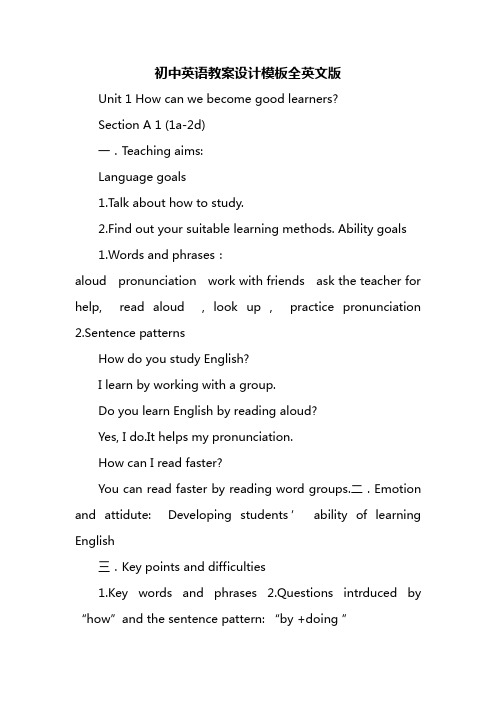
初中英语教案设计模板全英文版Unit 1 How can we become good learners?Section A 1 (1a-2d)一.Teaching aims:Language goals1.Talk about how to study.2.Find out your suitable learning methods. Ability goals1.Words and phrases:aloud pronunciation work with friends ask the teacher for help, read aloud , look up , practice pronunciation 2.Sentence patternsHow do you study English?I learn by working with a group.Do you learn English by reading aloud?Yes, I do.It helps my pronunciation.How can I read faster?You can read faster by reading word groups.二.Emotion and attidute: Developing students’ability of learning English三.Key points and difficulties1.Key words and phrases2.Questions intrduced by “how”and the sentence pattern: “by +doing ”四.Teaching procedures: Step 1 Warming upT: How do you study English? Do you study English by the following ways? (Show some pictures and present the important phrases.)T: How do you study English? S: I study English by ______.by working with friends.by making word cards.by asking the teacher for help.by reading the textbook.by working with a group.by listening tapes.Step 2 1a Check the ways you study English.Then add other ways you sometimes study.___ a.by working with friends.___ b.by making word card.___ c.by reading the textbook.___ d.by listening to tapes ___ e.by asking the teacher for help.…Step 3 Listening1) Listen.How do these students study for a test? Write letters from 1a above.2) Check the answers: b (Meiping); e (Peter); d (Tony) Step 4 Gue Show some pictures.Gue: How does he/she study English? He/She studies English by…How do they study English? They study English by… Step 5 Pairwork1c Make conversations about how you study for a test.A: How do you study for a test?B: I study by working with a group.A: How do you study for a test?B: I study by… Step 6 Listening2a Listen and check the questions you hear.1 ____ Does anyone learn English by watching videos? 2 ____ Do you have conversations with friends in English? 3 ____ What about listening to tapes? 4 ____ What about reading aloud to practice pronunciation? 5 ____ Have you ever studied with a group?Answers: 1, 2, 4, 5 2b Listen again.Match each answer below with a question above.a.Yes, I have.I’ve learned a lot that way.b.Oh, yes.It really improves my speaking skills.c.I do that sometimes.I think it helps.d.No.It’s too hard to understand spoken English.Answers: d, b, c, a Step 7 Pairwork 1.2c Make conversations using the information in 2a and 2bA: Have you ever studied with a group?B: Yes, I have.I’ve learned a lot that way.Show some pictures.1) A: Do you learn English by watching movies?B: Yes, it’s a very interesting way.C: No, it’s too hard to understand spoken English.2) A: What about writing letters to a pen pal in America?B: Yes, it helps to improve my writing skills and know a lot aboutAmerica.3) A: Do you have conversations with friends in English?B: Of course, we can talk about plenty of things like school, pets,movies, and our parents.Step 8 SummaryHow do you study English?1.by working with friends2.by watching English movies.3.by making word cards.4.by reading the textbook.5.by listening to tapes.6.by asking the teacher for help.7.by reading aloud.Step9 Homework How do you study English? What about physics and Chinese? Make a list.Oral Presentation of Leon Plan for Unit 12 My favorite subject is science Go for it Grade 7(注:本说课稿根据“2007年首届全国中学英语教师教学基本功大赛暨教学观摩研讨会(初中)”)[Presenting the 1st PPT about the introduction.] Well,good afternoon ladies and gentlemen, I am very happy to meet you all here.Today,I am going to present Unit 12 Writing.Well, please look at the teaching material together.Well, this is a letter in the book.Students are required to read it through, have a look at it, try to write a letter to Zhao Jie, a boy who doesn’t like any subjects at all.[Presenting the 2nd PPT about the given letter.]Well, I think my teaching aims should include the proper form of English letter, and second, how to write a letter in an idiomatic way.[Presenting the 3rd PPT about the teaching aims.]Well, to achieve these goals, I am going to arrange my teaching step by step [Presenting the 4th PPT about the teaching procedures].Well, these are the steps, since so many, let me make it simple, actually, they are words, sentences and paragraphs.As we know that articles consist of words and sentences.So first, I would like to talk about the words.That is also the first step---revision.Well, you know, students have learned the names of the subjects in the former leons.So, I am going to review the words by playing games with them.Here comes the first game: who can write more? [Presenting the 5th PPT about the 1st game]I am going to divide the students into two groups, for example boys and girls.They are given twominutes to rush to the blackboard and write down the subjects they know.The group which can write more will be the winner.Imagine how excited the students are, and at the same time, they are also reviewing the words.Well, what’s more, you may have noticed these two subjects, Physics and Chemistry.[Presenting the 6th PPT about the result of the game] Actually, these two subjects are not in this book.So, in this way, we can know that some students are showing us how much they know and all the students can also enlarge their vocabulary at the same time.Well, after words, I would like to turn to sentences.Here comes the second game, who can make it longer? [Presenting the 7th PPT about the 2nd game] I am going to give students a word, for example subject.Which students can make it longer? Well, you please.Favorite subject.Good.A phrase appears.Longer? You please.My favorite subject is English.Well, a sentence appears.Even longer? My favorite subject is English, I like it very much, it is so interesting.[Presenting the 8th PPT about the answers of the game]Well, you can see students are constructing words into sentences step by step.Well, this is the revision part.After that, it is time to read.From now, I am going to show students the given material so soon.Actually, instead, I am going toshow them those separated pieces.They should put them into the correct order[Presenting the 9th PPT about the reordering task].You know before the leon, I divided the whole letter into these four parts, why do I bother to do this? Well, you can see, in this way, students can put more attention to how to begin and how to end a letter.Then, they have a time, can have a chance to read through the whole article[Presenting the 10 th PPT about the reading material].Well, at the same time, they should also pick out those well used words and sentences, and share them with the whole cla.Then, they have a discuion “what information can we use? [Presenting the 11th PPT about the discuion task]Why talking about subjects? Of course, it is easy for them to find these information like these three ones ( time Additional material(The new Star Wars movie, Be Careful with Numbers) Teaching Objectives: Knowledge objectives: To enable students to listen and complete some exercises Ability Objectives: To encourage the students to have basic skills of listening.Emotion objectives: To cultivate the cooperation through peer interaction Teaching aids: Multi-media Teaching and learning method: Guiding for learning Teaching Procedures: I.Presentation Today we¡¯ll ha ve a cla on listening practice ¡°Be careful with numbers inlistening¡±: First we¡¯ll play a game.Then, we¡¯ll practice.Lead-in A game on number II.Performance: Quick and accurate response to numbers is very important in daily communication.Telephone numbers, addrees, prices, temperatures, time and dates all closely linked with the use of numbers .Besides, numbers also play a very important part in broadcast programmes such as reports Now let¡¯s listen to some advice from experts.Task 1 Be Careful with Numbers (Play the recorder Twice) Individual work¡úpair work(check the answer with your partner)¡úGroup work(Underline the important sentences.e.g.The differences between million and billion, ¡°-teen¡¯s¡± and ¡°-ty¡¯s¡± are ¡-..¡°Seventeen point five million.¡±¡-)Whole cla read the key sentences. Well-done! Numbers are all around us.Let us practice with numbers and learn to be good at numbers.(First read out the following numbers¡- Watch the screen) T ask 2 Listen to some statements about the brief history of films and TV.First check the answers in groups.If you have different opinion , please raise your hands.Judgement: (First students give themselves a judge.Then teacher does it) It seems no challenge.Now, We¡¯ll do challenge exercise.So pay special attention to the numbers in the paage and select the correct answer from the choiceslisted below.First teach the students new words in listening material.Then ask students to read out the numbers in Star Wars.III.Promotion: Challenge exercise Star Wars Listen to the tape twice ¡úCheck the answers IV.Conclusion: What we learned today is ¡°Be careful with numbers in numbers.¡± Remember the following points when you are doing listening tasks: 1.Take great care with the spelling of names and with addrees and phones numbers, prices, time and dates...2.To find the right answer, you may need to do simple calculations or combine two sets of data.3.Listen carefully for words and phrases such as these: half / twice as expensive as¡- it¡¯s shorter / cheaper / quicker than¡- the lightest / heaviest / newest not as long / cheap / good as¡- Some useful abbreviations and symbols for note taking( See PPt.) V.Aignment: 1.Review P6-7 ¨CFilling in forms P43¨C Working with numbers 2.Collect some information on listening skills Teaching Plan Be Careful with Numbers in Listening Cla: Cla 12, Senior Two Date: May 16,2007 Teacher: Ni Yazhen School: Zhi Yuan Senior High School Teaching Material: P75 S2B Oxford English; Additional material(The new Star Wars movie, Be Careful with Numbers) Teaching Objectives: Knowledge objectives: To enable students to listen andcomplete some exercises Ability Objectives: To encourage the students to have basic skills of listening.Emotion objectives: To cultivate the cooperation through peer interaction Teaching aids: Multi-media Teaching and learning method: Guiding for learning Teaching Procedures: I.Presentation Today we¡¯ll have a cla on listening practice ¡°Be careful with numbers in listening¡±: First we¡¯ll play a game.Then, we¡¯ll practice.Lead-in A game on number II.Performance: Quick and accurate response to numbers is very important in daily communication.Telephone numbers, addrees, prices, temperatures, time and dates all closely linked with the use of numbers .Besides, numbers also play a very important part in broadcast programmes such as reports Now let¡¯s listen to some advice from experts.Task 1 Be Careful with Numbers (Play the recorder Twice) Individual work¡úpair work(check the answer with your partner)¡úGroup work(Underline the important sentences.e.g.The differences between million and billion, ¡°-teen¡¯s¡± and ¡°-ty¡¯s¡± are ¡-..¡°Seventeen point five million.¡±¡-)Whole cla read the key sentences. Well-done! Numbers are all around us.Let us practice with numbers and learn to be good at numbers.(First read out the following numbers¡- Watch the screen) T ask 2 Listen to some statementsabout the brief history of films and TV.First check the answers in groups.If you have different opinion , please raise your hands.Judgement: (First students give themselves a judge.Then teacher does it) It seems no challenge.Now, We¡¯ll do challenge exercise.So pay special attention to the numbers in the paage and select the correct answer from the choices listed below.First teach the students new words in listening material.Then ask students to read out the numbers in Star Wars.III.Promotion: Challenge exercise Star Wars Listen to the tape twice ¡úCheck the answers IV.Conclusion: What we learned today is ¡°Be careful with numbers in numbers.¡± Remember the following points when you are doing listening tasks: 1.Take great care with the spelling of names and with addrees and phones numbers, prices, time and dates...2.To find the right answer, you may need to do simple calculations or combine two sets of data.3.Listen carefully for words and phrases such as these: half / twice as expensive as¡- it¡¯s shorter / cheaper / quicker than¡- the lightest / heaviest / newest not as long / cheap / good as¡- Some useful abbreviations and symbols for note taking( See PPt.) V.Aignment: 1.Review P6-7 ¨CFilling in forms P43¨C Working with numbers 2.Collect some information on listening skillsTeaching Plan ----Yang Xuefen Content: Unit 4 He said I was hardworking.>, Grade 8(¢ò) Time: March 12th, the 1st period, Place: Cla 6, Grade 8Teaching goals: 11.Knowledge goal: 1.Vocabulary: hard-working, be mad at, not---anymore 2.Patterns: What did Marcia say? She said she was she was having a party for Lanna.22.Ability goal: Learn to report what someone said correctly 33.Moral goal: To teach students not to report wrong meage or they may cause trouble.To be an honest and good kid, report what someone said correctly.Teaching aids: multi-mediaTeaching procedures: Step 1: Leading in by free talking with the students: Ask several Ss what they are going to do after school .Write their sentences on the Bb.How are you? How is your mother? What are you doing? What is your mother doing? What do you do in the morning? What about your mother? What are you going to do after school? What is your mother going to do after work? I¡¯m fine.My mother is fine.I¡¯m having a cla.My mother is working.I have leons in the morning? My mother works in the morning.I am going to play sports after school My mother is going to cook after work.Step 2: Pre-task T: Now I¡¯m going to report what xx saidto you: xx said he was fine.And he said his mother was fine, too.He said he was having a cla and his mother was working.He said he had leons in the morning and his mother worked in the morning.He said he was going to play sports after school.He said his mother was going to cook after work.Step 3: While-task 1.Observe the sentences on the blackboard, find out what is different in my report He/ She said--------.4.SBp26/1a: Write the words soap opera on the board.Point to the picture and ask students what they think a soap opera is.Point out the TV screens in the picture.Ask one student to read what the person says in the first picture .Then ask another student: What did she/he say? Help to answer: She/He said she/he was having a surprise party for Lana on Friday night.6.Repeat with the other pictures.SB Page 26 , 1b .Listen and Number the pictures.SB Page 27 , 2a students try to find out the right picture and say the name in English.Step 2 Lead-in 1.Free talk: (1) What is your star sign? (2) Can you tell me something about yourself? ( abilities, special qualities, characteristics) (3) How many students are under the same star sign as you? (Yesterday¡¯s homework) (4) What are they like? (clever, kind, generous, hard-working, brave, patient, polite¡-.) (5) Do you share similar characteristics? (Letstudents speak out as many adjectives about characters as poible.) 2.Do you know these words? They are also used to describe people.(T each the new words, and finish Exercise B on P10.) 3.Read the new words after the teacher.Then let students read the sentences by themselves.4.Do some more exercises to see if students have known all the words¡¯ meanings.Step 3 Reading 1.T: It¡¯s said that star signs can represent a person¡¯s characteristics.Let¡¯s check if it is true.Please listen to the tape and learn something about them.2.Reading task 1: After listening to the tape, do ¡°T¡± or ¡°F¡± questions.3.Reading task 2: Ask students some questions to check if they have known the main idea, with the books open.(1) Is Aries lazy? (2) Which star sign likes saving money? (3) Does Sagittarius like telling jokes? (4) Which star sign has the best imagination? (5) If your birthday is on 13th September, what is your star sign?4.Make students read the article paage by paage and try to find out the adjectives to describe people¡¯s characteristics with the picture of each star sign.(Esp.their own star sign) T: Whose star sign is Aries? When is your birthday? What characteristics do you have/ do this star sign have?Aries: energetic, active, impatient, selfish Taurus: stubborn, hard-working, patient Gemini: curious, clever, outgoing Cancer:kind Leo: strong, confident, generous Virgo: modest, practical Libra: polite, fair, elegant Scorpio: powerful, silly Sagittarius: humorous, lucky Capricorn: succeful, patient Aquarius: kind, wise, strange Pisces: generous, kind, gentle, easy-going, creative, imaginative5.Discuion: What is your star sign? Do you have the same characteristics as the star sign says? Do you think what the star signs say about people are facts? -- So we can have a conclusion: What the star signs say about people are not facts.We can just learn about star signs for fun.Step 4 Some More Exercises 1.What are your characteristics? Write a short description of your own characteristics.2.Then show your description to your partner.3.Discu with your partner whether or not you agree with each other.Step 5 Homework 1.Read the paage three times.2.Remember all the adjectives which describe a person¡¯s characteristics.Step 1 Revision 1.Ask students some questions while showing Picture 1.(1) How many star signs are there in a year?(2) How do you know your star sign? What decides your star sign? (3) Do the people under the same star sign share similar characteristics? (4) What characteristics do the people under your star sign have? 2.Explain the language points whileanswering the above questions.1) A year is divided into 12 different star signs.2) Your date of birth decides your star sign.3) People born under the same star sign share similar characteristics.3.Ask more questions about Reading 1) Which star sign doesn¡¯t give up easily? 2) Which star sign loves peace and doesn¡¯t like to argue with others? 3) Whic h star sign is suggested to forgive others for their mistakes? 4) Which star sign likes to dream about everything? 4.T each the language points by answering the above questions.(1) You are patient and do not give up easily.(2) You love peace and do not like to argue with others.(3) Sometimes it is silly of you not to forgive others for their mistakes.(4) You like to dream about everything.Step2 Group work 1.Show students some pictures and paages about some famous people.Let students gue what star signs they are? 2.Finish Part C2 on Page11, and then check the answers.3.Discuion: What kind of friend do you like to make? (Why?) What is his/her star sign? (Let students talk about his or her own characteristics and his or her friend¡¯s.)4.What star signs are suitable for these jobs? Why? Step 4 Conclusion What star signs say about people are not facts.We should work hard to make our dream come true.Step 5 Homework 1.Read the paage again and again.2.Do someexercises.初中英语教案设计Unit 1 Have you ever eneterd a competition? 教学内容:1.让学生学习和掌握现在完成时的用法 2.教学生学习新词汇,句型和语法3.解释并举例说明现在完成进行时主要形式【have/has V-ed】教学目标1.词汇和短语experience,ever,competition,airport,capta-in ,country,take off,come true,more than e.g.2.关键句: Has she visited China before? -No,she hasn’t.But I sent her a DVD and she’s watchd it.Have you ever entered a competition? -No,I haven’t.What do you reakon? It sounds brilliant! 3.学习和掌握语法;The present perfect tense 教学重点1.Words:cabin, stewad, reckon, brillnt2.Preposition:on ,in , 教学难点The present prefect tense[Have/has done] Has he visited China before?---No,he hasn’t.教学目标1.To learn new words2.Prectice listening and speaking3.Learning sentence 教学策划Listening,reading explaining and practicing 教学流程初中英语教学设计模板教案设计Food and drink教学内容分析饮食话题是学生们最感兴趣的话题之一。
最新初中英语教案英文版(优秀四篇)

最新初中英语教案英文版(优秀四篇)初中英语教案英文版篇一how many desks are there? there are thirty-two. a book ten bookshow many接可数名词复数形式的.句型;数字1-10的拼写多媒体、录音机课时 1s1: how many …are there-s2: there are…ng.g-up1)learn the numbers 1-10. then listen and match.2) students listen and say the numbers.3) listen and say:t: what’re these/those?s: they’re eyes..t: how many desks are there?s: there are 32.work in pairs. ask and say.s1: what’re these?1) write the numbers.2) look at the pictures and write the phrases.derkwork book.个人修改初中英语教案英文版篇二starter module3 unit1 课型 listeningandspeaking学习询问颜色句型what colour are …? they are red. how do you spell “red”? r-e-d.颜色词汇的拼写记忆多媒体、录音机课时 1ng.g-up1)look and learn theword:apple,banana,flower,tree,bird,cat2) look at the pictures and the colour words.3) listen and say:t: what colour are they?t: how do you spell “red”?s: r-e-d..work in pairs. ask and say.s1: what colour are they?s2: they’re….s1: how do you spell it?s2: …se1) read and match.2) look at the pictures and write the sentences.derkwork book.初中英语教案英文版篇三sectiona 1a-2d一、教学目的〔一〕知识与技能:1. 学习并掌握1a-2d的单词和短语(1) rainstorm, alarm, begin ,heavily ,suddenly, strange;(2)go off, pick up, take a shower, make sure;2. 掌握并运用句型(1)what were you doing yesterday at the time of the rainstorm?(2)when you called, i was having a shower.(3)so while you were sleeping, i called jenny and she helped me.(4)what were you doing when the rainstorm came?3.掌握过去进展时态的构造和功能,学会使用when和while从句。
英文初中英语教案

英文初中英语教案一、教学目标:1. 学生能够掌握基本的英语语法和词汇。
2. 学生能够进行简单的英语口语交流。
3. 学生能够理解简单的英语文章。
二、教学内容:1. 英语字母表。
2. 基本词汇。
3. 基本句型。
4. 简单语法。
三、教学方法:1. 任务型教学法:通过设定各种实际情境,让学生在完成任务的过程中学习和运用英语。
2. 交际型教学法:通过模拟真实的社交场景,让学生在交流中学习英语。
3. 情境教学法:通过创设各种生活情境,让学生在实践中学习英语。
四、教学步骤:1. 热身活动(5分钟):教师与学生用中文进行简单的自我介绍,然后引导学生用英语进行自我介绍。
2. 教学新知识(20分钟):(1)英语字母表:教师引导学生学习英语字母表,让学生熟悉26个字母的发音和书写。
(2)基本词汇:教师教授一些基本词汇,如:hello(你好),good morning(早上好),good afternoon(下午好),good evening(晚上好),how are you(你好吗),my name is(我的名字是)等。
(3)基本句型:教师引导学生学习一些基本句型,如:What's your name?(你叫什么名字?),How old are you?(你多大了?),Where are you from?(你来自哪里?)等。
(4)简单语法:教师简要介绍一些基本语法规则,如:主谓一致,名词所有格等。
3. 练习与巩固(15分钟):(1)教师设置一些情境,让学生进行角色扮演,运用所学知识进行口语交流。
(2)教师给出一些简单的英语文章,让学生进行阅读理解。
4. 总结与作业(5分钟):教师对本节课所学内容进行总结,布置作业,要求学生课后进行复习和练习。
五、教学评价:1. 课堂参与度:观察学生在课堂上的积极参与程度,以及学生的学习兴趣。
2. 口语表达能力:通过角色扮演等环节,评估学生的口语表达能力。
3. 阅读理解能力:通过课后作业和测试,评估学生的阅读理解能力。
初中英语教案全英文版
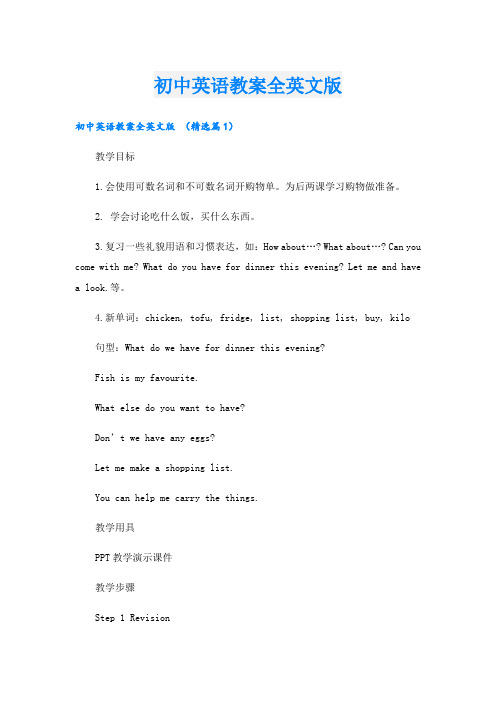
初中英语教案全英文版初中英语教案全英文版(精选篇1)教学目标1.会使用可数名词和不可数名词开购物单。
为后两课学习购物做准备。
2. 学会讨论吃什么饭,买什么东西。
3.复习一些礼貌用语和习惯表达,如:How about…? What about…? Can you come with me? What do you have for dinner this evening? Let me and havea look.等。
4.新单词:chicken, tofu, fridge, list, shopping list, buy, kilo句型:What do we have for dinner this evening?Fish is my favourite.What else do you want to have?Don’t we have any eggs?Let me make a shopping list.You can help me carry the things.教学用具PPT教学演示课件教学步骤Step 1 Revision[课件展示]教师在课堂上提问题,引导学生回答 What do you have for breakfast today? Shall we go and buy something to eat? What’s in the pictures? Let me see. What do we have for lunch today? How about…? What about…? What else do you want to have? Can you go and buy the things? Let’s go.等。
老师也可以同样的方式提问全班同学。
教师展示课件中Revision的食物图片,复习一些食品的名称。
Step 2 Presentation[课件展示]教师在复习食品名称基础上,引出购物的话题。
初中英语教案(英文版)
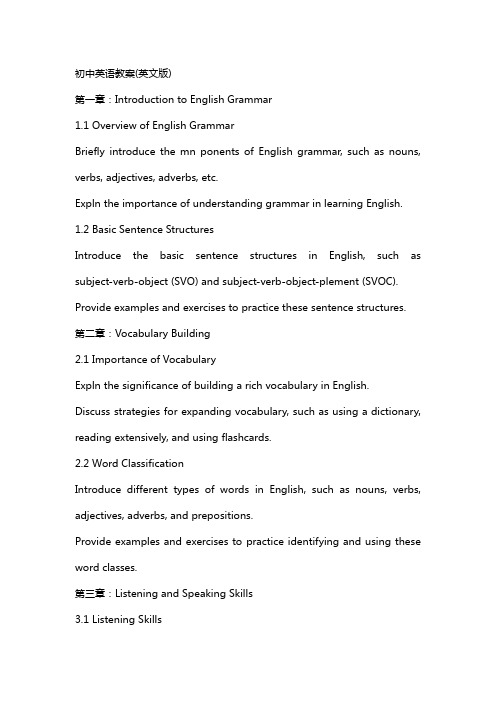
初中英语教案(英文版)第一章:Introduction to English Grammar1.1 Overview of English GrammarBriefly introduce the mn ponents of English grammar, such as nouns, verbs, adjectives, adverbs, etc.Expln the importance of understanding grammar in learning English. 1.2 Basic Sentence StructuresIntroduce the basic sentence structures in English, such as subject-verb-object (SVO) and subject-verb-object-plement (SVOC). Provide examples and exercises to practice these sentence structures. 第二章:Vocabulary Building2.1 Importance of VocabularyExpln the significance of building a rich vocabulary in English. Discuss strategies for expanding vocabulary, such as using a dictionary, reading extensively, and using flashcards.2.2 Word ClassificationIntroduce different types of words in English, such as nouns, verbs, adjectives, adverbs, and prepositions.Provide examples and exercises to practice identifying and using these word classes.第三章:Listening and Speaking Skills3.1 Listening SkillsDiscuss the importance of listening skills in learning English. Introduce strategies for improving listening prehension, such as active listening, note-taking, and predicting.Provide listening exercises with acpanying tasks to practice these skills.3.2 Speaking SkillsExpln the significance of speaking skills in munication.Introduce techniques for effective speaking, such as proper pronunciation, clear articulation, and appropriate intonation.Provide speaking exercises, including role-plays and discussions, to practice these skills.第四章:Reading Comprehension4.1 Importance of Reading ComprehensionDiscuss the importance of reading prehension in learning English. Expln how reading prehension skills can enhance understanding and enjoyment of English texts.4.2 Strategies for Reading ComprehensionIntroduce various strategies for improving reading prehension, such as skimming, scanning, and close reading.Provide reading passages with acpanying questions to practice these strategies.第五章:Writing Skills5.1 Basics of WritingIntroduce the basic elements of writing, such as topic, introduction, body paragraphs, and conclusion.Discuss the importance of proper formatting and citation in academic writing.5.2 Writing TechniquesExpln different writing techniques, such as narrative, descriptive, and persuasive writing.Provide writing prompts and exercises to practice these techniques, including peer review and editing.这五个章节涵盖了初中英语教学的主要内容,包括语法、词汇、听说技能、阅读理解和写作技巧。
初中英语教案(英语版)

1.Prepare much and think the teaching how can to be better
2.Talk with students after, know the student’s study condition
IX. Detailed task contents
1.summery the main sentence, words and expression
VII.Blackboard design
1.Write the topic of this class
2.Write the key words and sentences
3.Conclusion the moral goals enlightenment
1.Inspire student’s interests
2.Let student know the main content of this class
Step2: Presentation
1.Show some pictures of different weather in different places
2.Let them control the words and expression
Step 3 (mins)25mins
Step3:Ppractice
1.Practice sentences about different weather
2.Match the words with the pictures in 1a and check the answers
Key structures: What’s the weather like today\in…?
教案设计初中英语英文版
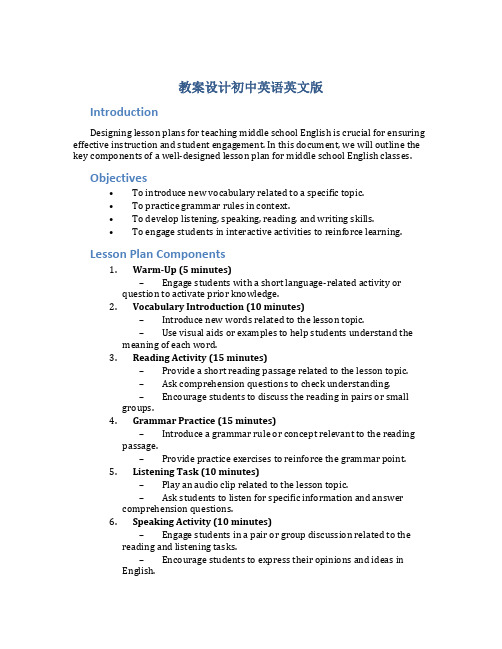
教案设计初中英语英文版IntroductionDesigning lesson plans for teaching middle school English is crucial for ensuring effective instruction and student engagement. In this document, we will outline the key components of a well-designed lesson plan for middle school English classes.Objectives•To introduce new vocabulary related to a specific topic.•To practice grammar rules in context.•To develop listening, speaking, reading, and writing skills.•To engage students in interactive activities to reinforce learning.Lesson Plan Components1.Warm-Up (5 minutes)–Engage students with a short language-related activity or question to activate prior knowledge.2.Vocabulary Introduction (10 minutes)–Introduce new words related to the lesson topic.–Use visual aids or examples to help students understand the meaning of each word.3.Reading Activity (15 minutes)–Provide a short reading passage related to the lesson topic.–Ask comprehension questions to check understanding.–Encourage students to discuss the reading in pairs or small groups.4.Grammar Practice (15 minutes)–Introduce a grammar rule or concept relevant to the reading passage.–Provide practice exercises to reinforce the grammar point.5.Listening Task (10 minutes)–Play an audio clip related to the lesson topic.–Ask students to listen for specific information and answer comprehension questions.6.Speaking Activity (10 minutes)–Engage students in a pair or group discussion related to the reading and listening tasks.–Encourage students to express their opinions and ideas in English.7.Writing Task (15 minutes)–Assign a short writing task that relates to the lesson topic.–Provide a writing prompt and encourage students to use new vocabulary and grammar concepts.8.Closure (5 minutes)–Review key vocabulary and grammar points covered in the lesson.–Assign homework or preview the next lesson topic.ConclusionDesigning effective lesson plans for middle school English classes requires careful consideration of the various components that make up a successful lesson. By incorporating a variety of activities that target different language skills, teachers can create engaging and meaningful learning experiences for their students.。
初中英语教案英文版简单

初中英语教案英文版简单Lesson Plan: Introduction to English PrepositionsObjective: Students will be able to understand and use basic English prepositions in sentences.Materials: Whiteboard, markers, flashcards with pictures, worksheet with sentences and pictures.Procedure:1. Introduction (5 minutes)Teacher writes the word "preposition" on the whiteboard and asks students if they have any ideas about what it means. Teacher then explains that prepositions are words that show the relationship between a noun or pronoun and another word in a sentence. Teacher gives a few examples, such as "in," "on," "under," and asks students to try to think of some themselves.2. Presentation (10 minutes)Teacher introduces flashcards with pictures of various prepositions and asks students to guess what the preposition is. Teacher gives examples of how to use each preposition in a sentence, and has students repeat after them. Teacher then writes each preposition on the whiteboard and gives more examples.3. Practice (10 minutes)Teacher gives students a worksheet with sentences and pictures, and asks them to circle the preposition in each sentence. Teacher goes over the answers with the class and corrects any mistakes.4. Application (10 minutes)Teacher divides students into pairs and gives each pair a worksheet with a picture and a blank space next to it. Teacher explains that students will take turns filling in the blank space with the correct preposition from a list given to them. Teacher goes over the answers with the class and corrects any mistakes.5. Summary (5 minutes)Teacher reviews the prepositions taught in the lesson and asks students to name a few of their own. Teacher then asks students to identify the preposition in a few sentences she writes on the whiteboard.Assessment:Teacher will assess students' understanding of prepositions through the worksheet and the activities during class.Extensions:For students who need more practice, teacher can give them additional worksheets or have them create their own sentences using the prepositions they have learned.For students who are advanced, teacher can introduce more complex prepositions and have them create more complex sentences.Note: This is just one example of a lesson plan, and can be adjusted according to the needs of the students and the available materials.。
2024年牛津译林版初中英语教案模板全英文
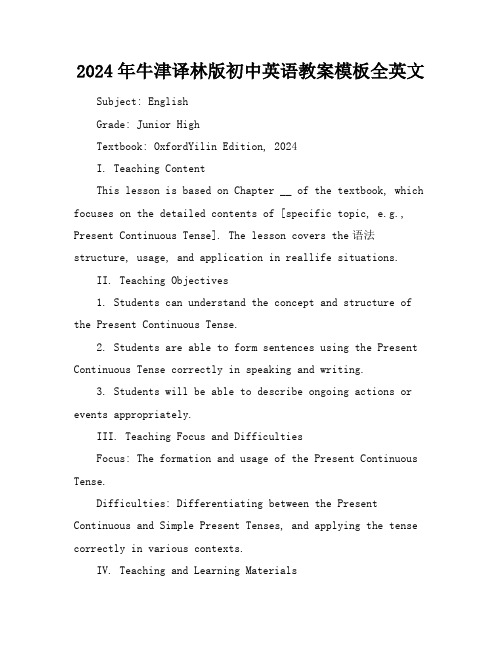
2024年牛津译林版初中英语教案模板全英文Subject: EnglishGrade: Junior HighTextbook: OxfordYilin Edition, 2024I. Teaching ContentThis lesson is based on Chapter __ of the textbook, which focuses on the detailed contents of [specific topic, e.g., Present Continuous Tense]. The lesson covers the语法structure, usage, and application in reallife situations.II. Teaching Objectives1. Students can understand the concept and structure of the Present Continuous Tense.2. Students are able to form sentences using the Present Continuous Tense correctly in speaking and writing.3. Students will be able to describe ongoing actions or events appropriately.III. Teaching Focus and DifficultiesFocus: The formation and usage of the Present Continuous Tense.Difficulties: Differentiating between the Present Continuous and Simple Present Tenses, and applying the tense correctly in various contexts.IV. Teaching and Learning Materials1. Textbook2. Whiteboard/Blackboard3. Visual aids (pictures, charts)4. Handouts with practice exercisesV. Teaching Process1. Introduction (5 minutes)Engage students with a practical scenario, e.g., showing pictures of people engaged in different ongoing activities.Elicit from students what they observe and encourage them to describe the actions using present tense.2. Presentation (15 minutes)Present the grammar rule of the Present Continuous Tense, emphasizing the usage of "am/is/are + verbing."Provide examples on the board, explaining the structure and function of the tense.Conduct choral repetition and individual practice to ensure understanding.3. Guided Practice (15 minutes)Give out handouts with guided exercises for students to practice forming sentences in Present Continuous Tense.Walk around the classroom to provide assistance and feedback.4. Interactive Activity (10 minutes)Organize an "Interview" activity where students ask and answer questions about ongoing actions using the Present Continuous Tense.5. Explanation and Clarification (10 minutes)Provide additional examples and practice to reinforce learning.6. Independent Practice (15 minutes)Assign a worksheet with various exercises, including fillintheblanks, sentence transformations, and writing prompts.Allow students to work individually while providing help to those in need.7. Review and Consolidation (10 minutes)Recap the main points of the lesson with students' participation.Review answers to the independent practice worksheet as a whole class.VI. Blackboard DesignThe board will be divided into sections:1. Title: Present Continuous Tense2. Grammar rules and examples3. Space for studentgenerated sentences4. Common errors and correctionsVII. Homework Design1. Write a short paragraph describing what your family members are doing right now.Example Answer: My brother is playing video games, my mother is cooking dinner, and my father is reading the newspaper.2. Create a dialogue between two friends meeting unexpectedly, using at least 10 sentences with the Present Continuous Tense.Answer Key will be provided with correct usage of the tense in the dialogue.VIII. Reflection and ExtensionReflect on the effectiveness of the practical scenario and interactive activities in engaging students.Consider modifications for future lessons to address any persisting difficulties.Provide extension activities for students seeking additional challenges, such as writing a story using the Present Continuous Tense or conducting an interview with a family member about their current activities.重点和难点解析:1. 教学难点与重点的明确;2. 教学过程中的实践情景引入;3. 教学过程中的互动活动设计;4. 板书设计;5. 作业设计;6. 课后反思及拓展延伸。
初中英语教案全英文版
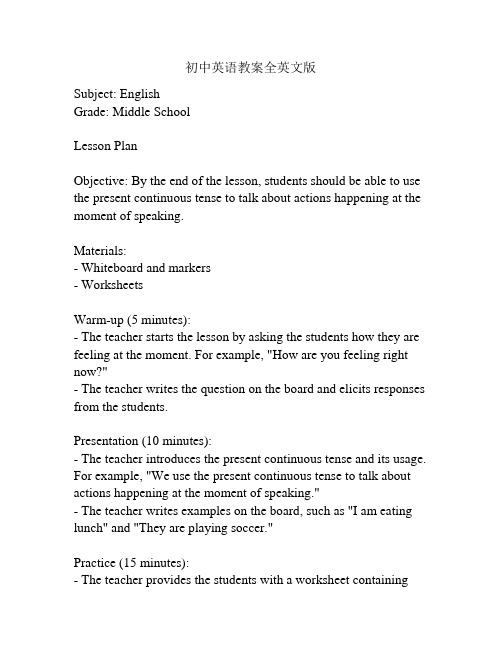
初中英语教案全英文版Subject: EnglishGrade: Middle SchoolLesson PlanObjective: By the end of the lesson, students should be able to use the present continuous tense to talk about actions happening at the moment of speaking.Materials:- Whiteboard and markers- WorksheetsWarm-up (5 minutes):- The teacher starts the lesson by asking the students how they are feeling at the moment. For example, "How are you feeling right now?"- The teacher writes the question on the board and elicits responses from the students.Presentation (10 minutes):- The teacher introduces the present continuous tense and its usage. For example, "We use the present continuous tense to talk about actions happening at the moment of speaking."- The teacher writes examples on the board, such as "I am eating lunch" and "They are playing soccer."Practice (15 minutes):- The teacher provides the students with a worksheet containingsentences in the present continuous tense.- The students work individually to complete the sentences.- The teacher collects the worksheets and checks for correctness. Production (20 minutes):- The teacher divides the students into pairs.- Each pair is given a picture depicting different activities.- The students take turns describing the activities in the picture using the present continuous tense.- The teacher circulates the room to monitor and provide assistance as needed.Review (5 minutes):- The teacher selects a few students to share their sentences with the class.- The teacher provides feedback on accuracy and pronunciation. Homework (5 minutes):- The teacher assigns homework for the students to practice using the present continuous tense. For example, they may be asked to write five sentences describing what they and their family members are doing at home.Note: The duration of each activity may vary depending on the level of the students and their ability to grasp the concept. The teacher should adapt and adjust the lesson accordingly.。
- 1、下载文档前请自行甄别文档内容的完整性,平台不提供额外的编辑、内容补充、找答案等附加服务。
- 2、"仅部分预览"的文档,不可在线预览部分如存在完整性等问题,可反馈申请退款(可完整预览的文档不适用该条件!)。
- 3、如文档侵犯您的权益,请联系客服反馈,我们会尽快为您处理(人工客服工作时间:9:00-18:30)。
Unit 1 How can we become good learners?
Section A 1 (1a-2d)
一.Teaching aims:
Language goals
1. Talk about how to study.
2. Find out your suitable learning methods.
Ability goals
1.Words and phrases:aloud pronunciation work with friends ask the teacher for
help, read aloud , look up , practice pronunciation
2.Sentence patterns
How do you study English?
I learn by working with a group.
Do you learn English by reading aloud?
Yes, I do. It helps my pronunciation.
How can I read faster?
You can read faster by reading word groups.
二.Emotion and attidute: Developing students’ ability of learning English 三.Key points and difficulties
1. Key words and phrases
2.Questions intrduced by “how”and the sentence pattern: “by +doing ”
四.Teaching procedures:
Step 1 Warming up
T: How do you study English? Do you study English by the following ways?
(Show some pictures and present the important phrases.)
T: How do you study English?
S: I study English by ______.
by working with friends.
by making word cards.
by asking the teacher for help.
by reading the textbook.
by working with a group.
by listening tapes.
Step 2 1a Check the ways you study English. Then add other ways you sometimes study.
___ a. by working with friends.
___ b. by making word card.
___ c. by reading the textbook.
___ d. by listening to tapes
___ e. by asking the teacher for help.
…
Step 3 Listening
1) Listen. How do these students study for a test? Write letters from 1a above.
2) Check the answers: b (Meiping); e (Peter); d (Tony)
Step 4 Guess
Show some pictures.
Guess: How does he/she study English? He/She studies English by…
How do they study English? They study English by…
Step 5 Pairwork
1c Make conversations about how you study for a test.
A: How do you study for a test?
B: I study by working with a group.
A: How do you study for a test?
B: I study by…
Step 6 Listening
2a Listen and check the questions you hear.
1 ____ Does anyone learn English by watching videos?
2 ____ Do you have conversations with friends in English?
3 ____ What about listening to tapes?
4 ____ What about reading aloud to practice pronunciation?
5 ____ Have you ever studied with a group?
Answers: 1, 2, 4, 5
2b Listen again. Match each answer below with a question above.
a. Yes, I have. I’ve learned a lot that way.
b. Oh, yes. It really improves my speaking skills.
c. I do that sometimes. I think it helps.
d. No. It’s too hard to understand spoken English.
Answers: d, b, c, a
Step 7 Pairwork
1. 2c Make conversations using the information in 2a and 2b
A: Have you ever studied with a group?
B: Yes, I have. I’ve lear ned a lot that way.
Show some pictures.
1) A: Do you learn English by watching movies?
B: Yes, it’s a very interesting way.
C: No, it’s too hard to understand spoken English.
2) A: What about writing letters to a pen pal in America?
B: Yes, it helps to improve my writing skills and know a lot about
America.
3) A: Do you have conversations with friends in English?
B: Of course, we can talk about plenty of things like school, pets,
movies, and our parents.
Step 8 Summary
How do you study English?
1. by working with friends
2. by watching English movies.
3. by making word cards.
4. by reading the textbook.
5. by listening to tapes.
6. by asking the teacher for help.
7. by reading aloud.
Step9 Homework
How do you study English? What about physics and Chinese?
Make a list.。
